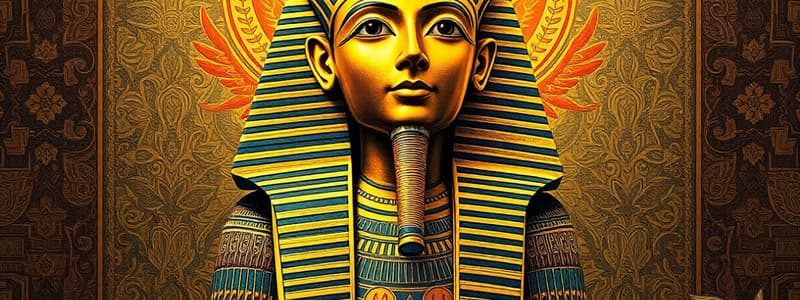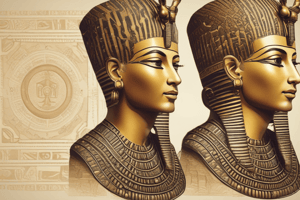Podcast
Questions and Answers
Amenhotep IV, known for initiating a radical shift in Egyptian religious practices, primarily promoted the worship of which deity or concept?
Amenhotep IV, known for initiating a radical shift in Egyptian religious practices, primarily promoted the worship of which deity or concept?
- Osiris, the god of the afterlife
- Amun, the traditional god of Thebes
- Ra, the ancient sun god
- Aten, the sun disk (correct)
Howard Carter discovered Tutankhamun's tomb in 1932 after a short search, finding it completely untouched by looters.
Howard Carter discovered Tutankhamun's tomb in 1932 after a short search, finding it completely untouched by looters.
False (B)
What was the primary method Howard Carter initially attempted to use to dislodge Tutankhamun's mummy from the solidified resins in his coffin?
What was the primary method Howard Carter initially attempted to use to dislodge Tutankhamun's mummy from the solidified resins in his coffin?
exposure to sunlight
After Akhenaten, a mysterious ruler briefly succeeded him, before __________ took the throne and restored the old ways.
After Akhenaten, a mysterious ruler briefly succeeded him, before __________ took the throne and restored the old ways.
Match the individuals with their roles or actions related to Tutankhamun's story:
Match the individuals with their roles or actions related to Tutankhamun's story:
The garlands of olives, lotus petals, and cornflowers found in Tutankhamun's coffin suggest that his burial took place during which time of the year?
The garlands of olives, lotus petals, and cornflowers found in Tutankhamun's coffin suggest that his burial took place during which time of the year?
The CT scan performed on Tutankhamun's mummy aimed solely to confirm the cause of his death, without providing insights into his life and health.
The CT scan performed on Tutankhamun's mummy aimed solely to confirm the cause of his death, without providing insights into his life and health.
Besides gold and precious items, name one type of everyday object that was found within Tutankhamun's tomb, providing insight into royal life at the time.
Besides gold and precious items, name one type of everyday object that was found within Tutankhamun's tomb, providing insight into royal life at the time.
Flashcards
Tutankhamun (Tut)
Tutankhamun (Tut)
Last ruler of the powerful Pharaoh Dynasty in Egypt; his death remains a mystery.
Howard Carter
Howard Carter
British archaeologist who discovered Tutankhamun's tomb in 1922.
CT Scan
CT Scan
Offered to solve the mystery surrounding Tut’s life and death.
Amenhotep III
Amenhotep III
Signup and view all the flashcards
Amenhotep IV / Akhenaten
Amenhotep IV / Akhenaten
Signup and view all the flashcards
Aten
Aten
Signup and view all the flashcards
Amun
Amun
Signup and view all the flashcards
Resins
Resins
Signup and view all the flashcards
Study Notes
- Tutankhamun was the last ruler of the powerful Pharaoh Dynasty in Egypt.
- He died as a teenager, and the cause of his death was a mystery, with some speculation of murder.
- He ruled over Egypt and its empire for centuries.
- Howard Carter, a British Archaeologist, discovered his tomb in 1922.
- Eighty years after its discovery, Tut's body was taken from its resting place for a CT scan to help solve the mystery of his life and death through forensic reconstruction.
Amenhotep III and IV
- Amenhotep III, likely Tut's father or grandfather, was a powerful Pharaoh who ruled for forty years.
- Amenhotep IV, his son, succeeded him and initiated a strange period in Egyptian history.
- Amenhotep IV promoted the worship of Aten (the sun disk).
- He changed his name to Akhenaten, meaning servant of the Aten.
- Akhenaten moved the religious capital from Thebes to a new city called Akhenaten (Amarna).
- He attacked the god Amun, destroying his images and closing his temples.
- A mysterious ruler succeeded Akhenaten, but died soon after.
- Tutankhaten changed his name to Tutankhamun and restored the worship of Amun, ruling for nine years until his mysterious death
Tomb Discovery and Investigation
- Tut's mummified body was discovered with gold, wealth, and everyday items like a bronze razor, games, clothes, cases of food, and wine.
- Carter searched for many years before discovering the tomb.
- Carter investigated Tut's three nested coffins in the rock-cut tomb, 26 feet underground, adorned with wall paintings.
- Some parts of the tomb's treasures had already been looted.
- Tut's face was gilded on the outer coffin.
Coffin Examination
- Garlands of olives, lotus petals, and cornflowers in the first coffin suggested he was buried in March or April.
- Resins used to cement Tut to the bottom of the solid gold coffin had hardened, making it impossible to move.
- Carter tried to loosen the resins by placing the coffin in the sun for several hours, but it didn't work.
- Ultimately, Carter used a chisel and hammer to remove the resins.
- Carter felt he had no choice but to cut the mummy from limb to limb to prevent thieves from looting the gold.
- His men removed Tut's head and then cut off every joint.
- After removing the body parts, they were placed on a layer of sand in a wooden box and put back in the original place.
Modern Analysis
- In 1968, an anatomy professor X-rayed the mummy, revealing that his breast bone and front ribs were missing.
- On January 05, 2009, Tut was taken for a CT scan, which uses hundreds of X-rays to create a three-dimensional image.
- During the CT scan, the scanner stopped working, pausing the procedure.
- Spare fans were used to get the scanner working again and complete the scan.
- After three hours, Tut's body was taken back to his tomb, where it rests in peace.
Studying That Suits You
Use AI to generate personalized quizzes and flashcards to suit your learning preferences.




